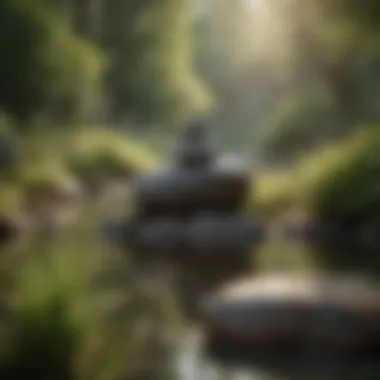Exploring Diverse Meditation Techniques for Clarity


Research Overview
Preamble to the topic under study
Meditation has garnered significant attention over the years, evolving into a popular practice across the globe. Traditionally rooted in spiritual and cultural practices, various forms of meditation now exist, each with distinct methodologies and goals. This exploration of different meditation techniques aims to clarify how these practices can enhance mental clarity and overall well-being in modern life.
Summary of existing research findings
Numerous studies indicate that meditation can positively impact psychological health. Research suggests it may reduce stress, increase focus, and improve emotional regulation. Moreover, advancements in neuroimaging techniques allow scientists to observe the brain's response to meditation. This has provided valuable insights into how mindfulness may occupy distinct areas of the brain associated with focus, awareness, and emotional balance.
Key research methodology explained
Most research in this area employs quantitative methodologies, including randomized controlled trials to assess the effectiveness of meditation techniques. Qualitative methods are also used to gather personal experiences and subjective impacts of meditation, providing a holistic view of its benefits. By combining these approaches, researchers have developed a more comprehensive understanding of meditation's impact on health and well-being.
Health Implications
Discussion on the impact of the research on health
The implications of research on meditation extend into health outcomes, revealing both physical and psychological benefits. Regular meditation has been linked to lower blood pressure, improved immune system function, and reduced signs of anxiety and depression. By practicing consistently, individuals can potentially mitigate stress-related illnesses and enhance physical health.
Exploration of potential benefits and risks
While the benefits of meditation are well-documented, it is essential to acknowledge potential risks. For some individuals, especially those with challenging mental health issues, meditation may initially trigger discomfort or anxiety. To minimize risks, it's crucial to approach meditation with realistic expectations and seek guidance when needed.
Examples of how the findings can be applied in daily life
Incorporating meditation into daily routines can be straightforward. Simple techniques can be practiced anywhere, allowing individuals to integrate mindfulness into busy schedules. Even short bursts of focused breathing or body scanning can significantly affect stress management and focus throughout the day.
Well-being Strategies
Practical tips and strategies derived from the research
Here are practical strategies derived from meditation research:
- Start Small: Begin with just a few minutes of meditation each day to build a habit.
- Choose Your Technique: Experiment with different techniques, such as mindfulness meditation, loving-kindness meditation, or transcendental meditation, to find what resonates with you.
- Create a Dedicated Space: Establish a peaceful area for meditation practice to enhance focus.
Advice on implementing positive changes for well-being
Consistency is key in meditation. Aim to dedicate time daily or a few times weekly to foster mindfulness gradually. Even a structured approach, like guided sessions via apps, can ease the transition into a regular practice without overwhelm.
Personal stories or case studies supporting the strategies
Several individuals report transformative experiences through meditation, leading to improvements in mental health and emotional resilience. For example, one practitioner noted significant changes in their ability to manage stress after regular mindfulness sessions over several months. These personal accounts emphasize how meditation can be an effective tool for meaningful change.
Expert Insights
Analysis of expert opinions on the research findings
Experts frequently advocate for the integration of meditation as a complementary practice in healthcare. By enhancing mental clarity, meditation may support treatment for various conditions, including anxiety disorders and chronic pain. Specialists argue for a more personalized approach, as not all techniques may suit every individual. Understanding one's needs is vital for effective practice.
Q&A session with a relevant expert on the topic
Interviews with experts reveal common themes: the importance of self-awareness in choosing the right technique and recognizing that meditation is a skill developed over time. According to Dr. Elena Rossi, a clinical psychologist who specializes in mindfulness practices, "The path to mastering meditation is unique for each person. It's about discovering what aligns best with your personal journey."
Links to related articles or studies for further reading
Recommended books, websites, or courses for in-depth learning
- The Miracle of Mindfulness by Thich Nhat Hanh.
- Wherever You Go, There You Are by Jon Kabat-Zinn.
- Websites like Insight Timer offer free courses and guided meditations.
Tools or apps that can assist in applying the research findings
Consider using apps like Headspace for guided meditation sessions. Alternatively, Calm provides a range of mindfulness and relaxation features.
"Incorporating even a few minutes of meditation can act as a catalyst for profound changes in lifestyle, resulting in improved mental state and overall health."
Prolusion to Meditation
Meditation is an ancient practice that has found relevance even in the fast-paced modern world. Understanding meditation is essential for anyone looking to enhance their mental health, emotional well-being, or personal growth. More than mere relaxation, meditation serves many purposes that can be profound and life-changing.
Definition and Purpose
Meditation can be broadly defined as a practice where an individual uses techniques, such as mindfulness or focusing the mind on a particular object, thought, or activity, to train attention and awareness. The primary purpose of meditation is to cultivate a sense of inner peace, clarity, and concentration. This training can affect numerous aspects of life, fostering emotional stability, enhanced focus, and overall mental clarity.
Practitioners often pursue meditation to accomplish several goals, such as reducing stress, increasing self-awareness, or improving emotional health. By dedicating time to meditate, individuals may notice improved mood and resilience, leading to healthier interactions and decisions.
Historical Context of Meditation
The roots of meditation can be traced back thousands of years, intersecting various cultures and spiritual traditions. Techniques and practices developed in ancient times, particularly in regions such as India and China, were often intertwined with religious beliefs. Various texts, including the Vedas and the Tao Te Ching, mention meditation as a means to spiritual enlightenment.
In the West, the adoption of meditation has gradually gained popularity, particularly through the late 20th and early 21st centuries. This has led to the emergence of secular forms of meditation, accessible to a wider audience, disconnected from religious connotations.
"Meditation is not a way of making your mind quiet. It's a way of entering into the quiet that’s already there – buried under the 50,000 thoughts the average person thinks every day." – Deepak Chopra
Understanding this historical context provides insight into the evolution of meditation practices and their diverse applications today. By appreciating its rich tradition, readers can better contextualize how these techniques fit into contemporary lifestyles.
Mindfulness Meditation
Mindfulness meditation is a practice that has become increasingly important in the conversation around mental health and wellness. This technique focuses on achieving a state of awareness and presence, allowing individuals to better navigate their thoughts and emotions. It is essential to understand how this form of meditation fits into the larger context of various techniques available today.
Concept and Principles
Mindfulness meditation is grounded in the concept of being fully present in the moment, without judgment. This involves observing thoughts, feelings, and sensations as they arise, rather than becoming attached to them. The principle of mindfulness encourages practitioners to cultivate an attitude of openness and acceptance towards their experiences.
This technique has roots in ancient traditions, particularly in Buddhism, but has been adapted to fit modern contexts. It enables individuals to create a more profound connection with their inner selves, enhancing emotional regulation and reducing stress.
Techniques for Practicing Mindfulness
Body Scan
The body scan is a specific technique often used in mindfulness meditation. This process involves mentally scanning the body from head to toe, noticing any areas of tension or discomfort.


The unique feature of the body scan lies in its focus on bodily sensations. This aspect contributes significantly to overall well-being, fostering a connection to physical presence. It helps practitioners develop awareness of their bodies, promoting relaxation as they gently release tension.
Its advantages include its simplicity and accessibility. One downside is that it may require a quiet space and time commitment to be effective.
Focused Breathing
Focused breathing is another essential technique within mindfulness meditation. It involves concentrating on the breath, observing its natural rhythm. This practice helps in grounding the mind, providing a focal point that can help divert attention from stress and anxiety.
The primary characteristic of focused breathing is its immediate calming effect on the nervous system. This technique can be especially beneficial for individuals facing overwhelming thoughts or feelings.
Its unique feature is that it can be practiced almost anywhere and at any time, making it a popular choice for many. However, the challenge may lie in maintaining focus, especially for those new to meditation.
Benefits of Mindfulness Meditation
The practice of mindfulness meditation offers a variety of benefits that contribute to overall mental health. Research has shown that it can significantly reduce stress and anxiety levels while improving emotional regulation. Typical benefits of the practice include:
- Enhanced awareness of thoughts and emotions
- Improved concentration and focus
- Greater resilience to stressors
- Increased overall well-being
"Mindfulness meditation can transform the way we relate to ourselves and the world, making it a valuable tool for personal growth."
Transcendental Meditation
Transcendental Meditation (TM) presents a unique approach to meditation that emphasizes simplicity and deep relaxation. It allows practitioners to access a profound state of mental stillness while minimizing effort. This technique, developed by Maharishi Mahesh Yogi, has gained popularity for its ability to reduce stress and enhance overall well-being. It is essential in the broader discussion of meditation because it offers a contrast to more intensive methods, like mindfulness or Zen meditation. While it shares some similarities with these practices, TM maintains a distinct process that highlights the power of silencing the mind.
Fundamentals of Transcendental Meditation
At its core, Transcendental Meditation is easy to learn and practice. It requires no particular belief system, making it accessible for people from diverse backgrounds. This technique involves using a specific sound or mantra that is repeated silently, which guides practitioners into a tranquil mental state. By focusing on this sound, individuals can transcend their thoughts and experience deep relaxation.
A typical TM session lasts about 20 minutes and is recommended twice daily, allowing practitioners to cultivate a consistent practice without it feeling burdensome. Research suggests that TM can enhance cognitive functions and reduce anxiety. Participants often report feeling more alert and sharpened after sessions, which contrasts with the emotional fatigue experienced in other meditation forms.
The Technique of Silent Repetition
The technique of silent repetition is a vital component of Transcendental Meditation. The mantra used is chosen specifically for each practitioner, which adds a personal touch to the practice. This allows individuals to create a connection with their meditation. When practicing, the mantra is repeated effortlessly in a thoughtless manner, which means that practitioners should not focus intensely on it. Instead, it serves as a vehicle to experience pure awareness, moving past the mental chatter that often occupies the mind.
"Transcendence is not a goal but a state to be experienced, allowing us to tap into deeper levels of consciousness."
The beauty of this technique lies in its simplicity. Unlike other meditation forms that require strict concentration, TM encourages a gentle recognition of thoughts without judgment. If a thought arises, practitioners are advised to simply acknowledge it and return to the mantra, reinforcing the idea of effortless awareness.
Research on Benefits and Effects
Numerous studies have explored the effects of Transcendental Meditation on mental health and overall well-being. Research indicates that TM can significantly reduce stress and anxiety levels. A study conducted at Harvard showed that regular practitioners exhibited changes in brain activity that correlated with decreased stress reactions.
Moreover, TM has been linked to improvements in cardiovascular health. A meta-analysis published in the Journal of the American Heart Association reported lowered blood pressure and reduced risk factors associated with heart disease. Perhaps most critical is that TM has become increasingly recognized as an effective tool for managing mental health conditions like depression.
In summary, Transcendental Meditation stands out as a practical method for achieving relaxation and mental clarity. It encourages a non-strenuous approach, making it suitable for anyone interested in enhancing their meditation practice.
Zen Meditation
Zen meditation holds a vital place in the landscape of meditation practices. It is deeply rooted in Japanese and Chinese traditions. This form of meditation emphasizes simplicity, clarity, and direct experience of reality. It is not merely about relaxation but invites one to engage fully with the present moment. With its focus on alertness, Zen meditation cultivates a sense of awareness of thoughts, feelings, and bodily sensations. The practice of Zen meditation can help individuals navigate the complexities of modern life and foster mental resilience.
Origins and Philosophy
The origins of Zen meditation can be traced back to the teachings of the Buddhist monk Bodhidharma. He is credited with introducing Chan Buddhism to China, which later influenced the development of Zen. The core philosophy of Zen centers around the idea of direct experience and the nature of enlightenment. Unlike other forms of meditation that may rely on elaborate techniques, Zen encourages practitioners to see things as they are, without the filters of preconceived notions. This approach is grounded in the belief that every moment is an opportunity for insight.
Seated Meditation Practices
Zazen
Zazen, or "seated meditation," is a foundational practice within Zen. It involves sitting in a specific posture, often cross-legged, while focusing on the breath. This focus helps to quiet the mind and fosters a deeper level of awareness. One key characteristic of Zazen is its emphasis on a correct posture, which is believed to facilitate a harmonious flow of energy throughout the body. Many find Zazen to be effective for cultivating patience and concentration. However, beginners may find it challenging to maintain stillness for extended periods, which can be a barrier for some practitioners.
Kinhin
Kinhin is the practice of walking meditation that complements Zazen. It typically occurs between periods of seated meditation. The key characteristic of Kinhin is the slow and mindful walk, which brings awareness to each step. This practice encourages practitioners to remain connected with their bodies and surroundings, promoting mindfulness in movement. Kinhin offers a unique feature of transitioning from seated to active meditation, which can be refreshing for those feeling restless. Its rhythmic quality can support the calming effects experienced during Zazen and enhance overall mindfulness.
Benefits of Zen Meditation
Zen meditation offers a wealth of benefits that can influence various aspects of life. It helps in reducing stress and anxiety, providing a space for introspection and self-discovery. Regular practice can improve focus and creativity by training the mind to hone in on the present moment. Furthermore, Zen meditation can foster emotional stability. As practitioners learn to observe their thoughts without attachment, they become less reactive to external circumstances. This skill can lead to improved relationships and personal growth.
Zen meditation encourages practitioners to engage fully with the present, transforming moments of stillness into profound experiences of clarity.
Loving-Kindness Meditation
Loving-Kindness Meditation is a practice that centers on the cultivation of an attitude of love and kindness toward oneself and others. This type of meditation is significant in the broader context of mindfulness and emotional well-being. It provides not only a pathway to enhance personal compassion but also has been recognized for its potential to foster healthier relationships and emotional resilience. By integrating appreciation for others into one's practice, individuals can shift their perspective from self-centeredness to greater empathy and connectivity.
Prolusion to Loving-Kindness
Loving-Kindness Meditation, also known as Metta Bhavana, originates from the Buddhist tradition. The central premise of this technique is to encourage feelings of goodwill and compassion. The practice typically involves silently repeating phrases such as "May I be happy, may I be safe, may I be healthy, may I live with ease." This focus on self-compassion is crucial, as it sets the stage for extending these feelings to others.
The essence of Loving-Kindness lies in its ability to expand one’s emotional horizons. While it is often initiated as a personal practice, it evolves into broader applications where practitioners begin to wish well for friends, acquaintances, and even those with whom they may have conflicts. This gradual widening of the emotional circle promotes inclusivity and breaks down barriers of resentment which often plague human interactions.
Practicing Loving-Kindness
Practicing Loving-Kindness Meditation generally follows a structured approach. Here are the common steps involved:
- Find a Comfortable Position: Sit comfortably in a quiet location where you won’t be disturbed.
- Focus on Yourself: Begin by directing kind thoughts and phrases towards yourself. Emphasize authenticity in your expressions.
- Expand Your Focus: After a few minutes, shift your attention to a loved one. Imagine them experiencing happiness and offer phrases of goodwill.
- Broaden Outward: Gradually include neutral persons and even those you find challenging. This step requires patience and an open heart.
- Seal the Practice: Conclude by returning your focus to yourself, reinforcing feelings of warmth and kindness.
By repeating these steps consistently, practitioners often find a shift within their emotional landscape. Reduced reactivity and increased emotional balance can become lasting benefits over time.
Effects on Emotional Well-Being
The benefits of Loving-Kindness Meditation extend beyond immediate emotional satisfaction. Research indicates positive impacts on various aspects of mental health. Practitioners may experience:
- Increased Positive Emotions: Regular practice fosters a surplus of positive feelings which can combat negative thoughts.
- Greater Resilience: Respondents often report enhanced coping skills in stress-inducing situations, illustrating resilience.
- Improved Relationships: The practice encourages participants to relate to others with compassion, improving interpersonal connections.
- Reduced Symptoms of Anxiety and Depression: Studies suggest that this meditation helps alleviate some symptoms by shifting focuses away from self-doubt and negativity.
According to recent studies, engaging in Loving-Kindness Meditation can lead to noticeable increases in levels of happiness and overall life satisfaction.
Body Scan Meditation
Body Scan Meditation is a valuable technique that promotes heightened body awareness and relaxation. It serves as an important element in the broader spectrum of meditation practices. This method encourages individuals to cultivate mindfulness over their physical state, allowing for a deep sense of connection between the mind and body. Furthermore, it offers various benefits that can positively impact mental and physical health, making it a worthwhile practice for anyone seeking to optimize their well-being.
Overview of Body Scan Technique
The Body Scan technique is a systematic and gradual approach. Practitioners focus their attention on different parts of the body, often starting from the toes and moving upwards or vice versa. The goal is to notice sensations, tension, or relaxation in each area while maintaining a non-judgmental awareness. This process helps in fostering acceptance and understanding of one’s physical state, which can lead to greater emotional resilience.
Steps to Perform Body Scan


- Find a Comfortable Position: Lie down or sit in a relaxed position in a quiet space.
- Close Your Eyes: Begin by gently closing your eyes to minimize distractions.
- Breathe Deeply: Take a few deep breaths to center yourself and become aware of your breath.
- Focus on Toes: Start with your toes, noticing any sensation. Breathe into that area.
- Progress Gradually: Move your focus to your feet, then ankles, calves, and so on, up to your head. Spend a few moments on each body part.
- Acknowledge Sensations: Notice feelings of tension or relaxation without trying to change them. Just observe.
- End the Practice: Once you reach the top of your head, take a moment to breathe deeply before gradually coming back to the present moment.
Benefits for Body Awareness
Engaging in Body Scan Meditation yields significant benefits for overall body awareness:
- Enhanced Awareness: Practitioners develop a stronger connection with their body, improving their ability to recognize tension and discomfort.
- Stress Reduction: By bringing attention to physical sensations, stress can be reduced, leading to a calmer mind.
- Improved Emotional Regulation: Increased awareness allows for better recognition of emotional triggers related to physical sensations.
- Mindfulness Development: This practice boosts mindfulness skills, promoting a non-reactive awareness that can translate to everyday life.
Body Scan Meditation enhances personal awareness and reduces stress, making it a practical tool for emotional well-being.
Guided Meditation
Guided meditation involves a meditation practice wherein an instructor or a recording guides participants through a series of techniques. This method can help both beginners and experienced practitioners enhance their meditation sessions. Its importance lies in the guidance it provides, especially for those who may feel overwhelmed by the concepts and techniques of meditation. Guided meditation can serve various purposes, from relaxation to emotional healing and self-discovery. This approach often incorporates visualizations, breathing techniques, and mindfulness practices to help practitioners reach a desired state of calm and focus.
Understanding Guided Meditation
Guided meditation is accessible for anyone interested in developing a meditation practice. It typically starts with a focused intention, and a session may begin with the facilitator encouraging participants to settle into a comfortable position. The instructor may utilize verbal cues to help direct attention and awareness during the practice. This support can simplify the meditation process, making it less intimidating for newcomers. It provides structure and minimizes distractions, allowing the mind to center and engage more fully in the meditative experience.
Types of Guided Meditation Sessions
Live Sessions
Live sessions are often conducted by experienced instructors in real-time, either in-person or through online platforms. This format allows for interaction between the facilitator and participants, creating a sense of community and immediacy. A key characteristic of live sessions is the ability to tailor the meditation experience based on group reactions or individual needs. This adaptability makes live sessions a popular choice; they provide a space for participants to ask questions and receive instant feedback, enriching the overall meditation experience.
Advantages of live sessions include:
- Direct communication with the instructor
- Immediate guidance and support
- Enhanced motivation through group energy
However, disadvantages can be the scheduling dependency and potential disruption due to varying participation levels.
Pre-recorded Sessions
Pre-recorded sessions refer to audio or video meditations that users can experience at their convenience. This type of guided meditation allows for flexibility, as individuals can select sessions that best suit their schedule and preference. The key characteristic of pre-recorded sessions is their availability; they can be revisited multiple times, which is ideal for building a consistent practice. They are often a beneficial choice for those who prefer a less structured approach to meditation, while still enjoying guided support.
Advantages of pre-recorded sessions include:
- Accessibility at any time
- Freedom to repeat sessions as needed
- Variety in themes and topics available
However, disadvantages might include less personal interaction and the potential for a distracted experience if someone listens while multitasking.
Applications and Uses
Guided meditation is widely applied across various settings, from wellness retreats to corporate environments aiming to foster productivity and reduce stress. Many mental health professionals incorporate guided meditation as a therapeutic tool, assisting clients in processing emotions and achieving mental clarity. Schools increasingly recognize the value of guided meditation in promoting emotional well-being among students, helping them develop coping strategies amid academic pressures.
In summary, guided meditation offers a practical approach for individuals seeking to delve deeper into their practice. Whether through live interactions or pre-recorded sessions, this technique provides valuable resources that can enhance one's meditation journey. The diverse applications extend its benefits across personal, educational, and professional fields.
Chakra Meditation
Chakra Meditation holds a unique place within the realm of meditation techniques. It focuses on the energy centers in the human body, known as chakras. These chakras are believed to be integral to one's physical, emotional, and spiritual well-being. By engaging in Chakra Meditation, individuals aim to balance and align these energy points, enhancing their overall health and vitality. Understanding this process is essential as it integrates physical awareness, emotional health, and spiritual growth.
Fundamentals of Chakra Meditation
Chakra Meditation is rooted deeply in ancient Indian traditions, primarily associated with yoga and Ayurveda. There are seven main chakras located along the spine, each corresponding to specific physical and emotional functions. Here is a brief overview of these chakras:
- Root Chakra (Muladhara): Grounding and stability
- Sacral Chakra (Svadhisthana): Creativity and emotional balance
- Solar Plexus Chakra (Manipura): Personal power and confidence
- Heart Chakra (Anahata): Love and compassion
- Throat Chakra (Vishuddha): Communication and expression
- Third Eye Chakra (Ajna): Intuition and perception
- Crown Chakra (Sahasrara): Spiritual connection and enlightenment
Each of these chakras plays a pivotal role in one's health. When they are blocked or out of alignment, physical and emotional issues may arise. Thus, Chakra Meditation seeks to address these imbalances through focused meditation, visualization, and breathing techniques.
Techniques for Chakra Alignment
Practicing Chakra Meditation involves a variety of techniques. Here are some common methods:
- Visualization: Focusing on each chakra while visualizing its color and qualities can enhance energy flow. For example, envision a vibrant red light for the root chakra, representing stability.
- Mantras: Chanting specific sounds (often referred to as bija mantras) associated with each chakra can promote healing. For instance, “LAM” is commonly associated with the root chakra.
- Breathing Exercises: Controlled breathing helps activate and balance chakras. Inhale deeply while focusing on the chakra, then exhale tension and negativity.
- Body Postures: Certain yoga poses are designed to open and align chakras. Poses like the Mountain Pose or Child’s Pose can facilitate this process.
- Crystal Therapy: Using crystals corresponding to specific chakras can amplify energy. For instance, amethyst for the crown chakra or citrine for the solar plexus chakra.
"Balancing your chakras can work to enhance your clarity and emotional stability."
Benefits of Chakra Meditation
Engaging in Chakra Meditation can yield numerous benefits. These can include:
- Enhanced Emotional Health: Individuals often report improved mood and emotional balance after regular practice.
- Increased Self-Awareness: Chakra Meditation encourages introspection, leading to better understanding of one’s emotions and behaviors.
- Physical Healing: Some practitioners claim to experience relief from various physical ailments through balanced chakras.
- Spiritual Growth: Alignment of the chakras is often linked to a deeper spiritual connection and enlightenment.
- Stress Reduction: The meditative aspect helps promote relaxation and decrease stress levels.
In summary, Chakra Meditation is an essential practice for those seeking to enhance their overall well-being. It provides a structured approach to improve physical, emotional, and spiritual health through the alignment of energy centers in the body. Integrating this technique into one's daily routine can offer a pathway to self-discovery and greater harmony.
Sound Meditation
Sound meditation has become a prominent practice in the realm of meditation techniques. It utilizes sound as a focal point to achieve a deeper state of mindfulness and relaxation. The importance of sound meditation lies in its ability to impact the mind and body, offering unique therapeutic benefits that complement other meditation forms. Those interested in optimizing their health and well-being will find sound meditation particularly beneficial, providing a pathway to enhance their overall mental clarity and emotional stability.
Definition of Sound Meditation
Sound meditation refers to a practice where participants focus on sound, including music, chanting, or instruments, as a means to foster a meditative state. This approach encourages individuals to immerse themselves in auditory experiences, which can help quiet the mind and deepen awareness of the present moment. In many cases, practitioners use repetitive sounds to help facilitate relaxation and focus.
Instruments Used in Sound Meditation
Several instruments are pivotal in sound meditation. These include:
- Gong: Produced deep, resonating tones that vibrate through the body, creating a rich soundscape.
- Tibetan Singing Bowls: These bowls produce harmonic sounds through friction and are often used for their calming properties.
- Chimes: Offer lighter, more ethereal sounds that can enhance concentration and surrounding awareness.
- Drums: Often utilized to establish a rhythmic beat, helping to ground the practitioner and guide the meditative experience.
- Flutes: Their melodious tones can evoke relaxation and create a soothing atmosphere.
Each of these instruments contributes to the meditative experience by creating a multi-layered auditory environment that fosters deep relaxation.
Therapeutic Effects of Sound Meditation
Numerous studies have investigated the therapeutic effects of sound meditation. Among the prominent benefits are:
- Reduction of Stress: Engaging with sound can lower cortisol levels, which aids in stress reduction.
- Improved Focus: The method of concentrating on sound helps sharpen attention and reduces distractions.
- Emotional Healing: Sound promotes emotional release, which can assist in processing difficult feelings and trauma.
- Enhanced Sleep Quality: Many practitioners report improved sleep patterns as a result of regular sound meditation.
"Sound meditation is not merely a practice; it is an experience that engages the senses while promoting well-being."
Incorporating sound meditation into your routine may lead to significant improvements in both mental health and physical wellness. As awareness of its advantages grows, more individuals are embracing this form of meditation to augment their well-being journey.
Vipassana Meditation
Vipassana Meditation, often recognized as one of the most ancient forms of meditation, plays a crucial role in understanding various meditation techniques. Its significance stems not only from its rich heritage but also from its practical implications for personal growth and mindfulness. Vipassana, which means "clear seeing" in Pali, encourages practitioners to observe their thoughts, feelings, and sensations, fostering a deeper connection with the present moment.
Explanation of Vipassana


Vipassana is rooted in Buddhist traditions and aims to develop insight into the nature of reality through direct experience. Unlike some other forms of meditation that may focus primarily on concentration, Vipassana emphasizes an all-encompassing awareness. Practitioners are taught to observe their thoughts without judgment. This process can lead to a profound understanding of one’s habitual reactions and emotional patterns.
The technique involves systematic observation of the breath, bodily sensations, and thoughts. This creates a solid foundation for self-awareness, allowing individuals to recognize their mental states as they arise and pass away. The goal is not to suppress thoughts or feelings but to acknowledge them freely.
Steps to Practice Vipassana
Practicing Vipassana can be done independently or during a structured retreat. Here are key steps to begin:
- Find a Quiet Space: Select a calm and distraction-free environment.
- Assume a Comfortable Position: Sit in a comfortable, stable posture. This can be on a cushion or chair, with a straight back.
- Focus on Breath: Start by observing your breath. Notice the natural inhalation and exhalation.
- Release Thoughts: As thoughts arise, acknowledge them without attachment. Then return to your breath.
- Body Sensations: Gradually expand your awareness from your breath to your entire body. Notice sensations, tension, and discomfort.
- Regular Practice: Aim for consistent practice. Begin with shorter sessions, incrementally lengthening your time as you become accustomed.
Benefits of Vipassana Meditation
The benefits of Vipassana Meditation extend beyond the cushion into everyday life. Practitioners often report the following advantages:
- Increased Mindfulness: Enhances awareness of one’s thoughts and actions in daily routines.
- Emotional Regulation: Helps manage stress, anxiety, and emotional turbulence by fostering acceptance and non-reactivity.
- Greater Clarity: Encourages clear thinking and reduces confusion stemming from overwhelming emotions or fast-paced living.
- Enhanced Concentration: Improves focus and attention through training the mind to remain present.
"Vipassana Meditation transforms one's perspective, allowing for a clearer understanding of the self and the environment."
Movement-Based Meditation
Movement-based meditation combines physical activity with mindfulness. Such practices enhance not only our physical health but also our mental clarity. They help in focusing the mind while promoting body awareness. This approach enables individuals to find balance and calm through movement. Thus, it serves to integrate movement with meditation, enriching both practices.
Overview of Movement Techniques
Movement-based meditation can take many forms. Two of the most recognized techniques include Tai Chi and Yoga. Each offers unique benefits while fostering a meditative state through movement.
Tai Chi
Tai Chi is an ancient Chinese martial art. It involves slow, graceful movements. This practice helps in grounding oneself. One key characteristic of Tai Chi is its emphasis on balance and flow. It is often called "moving meditation," as it allows practitioners to become more aware of their body movements.
The popularization of Tai Chi in modern contexts showcases its adaptability. It has proven beneficial for stress reduction and mental clarity. The unique feature of Tai Chi is its focus on breath and posture. The advantages include improved flexibility and strength. However, beginners may find it challenging to learn due to its fluidity and complexity. Nevertheless, with consistent practice, the rewards can be significant.
Yoga
Yoga is another well-known form of movement-based meditation. It combines physical poses, breathing exercises, and meditation. A key characteristic of Yoga is its diversity; it offers many styles from vigorous vinyasa to gentle restorative poses. Yoga is popular for enhancing physical fitness and mental focus alike.
The unique feature of Yoga is its holistic approach. It addresses not just the body but also the mind and spirit. Advantages include increased flexibility and muscle tone, along with stress reduction. However, it is important to choose a style that fits individual needs. Beginners might feel overwhelmed by the range of practices available.
Mindfulness in Movement
Practicing mindfulness in movement essentially means being present during physical activities. It encourages awareness of each step, breath, and gesture. Engaging fully allows individuals to connect deeply with their bodies. This practice highlights the importance of attention in movement-based meditation. By incorporating mindfulness, practitioners gain more from their movements and can experience increased tranquility.
Health Benefits of Movement-Based Meditation
Movement-based meditation has several health benefits. Here are some of the notable ones:
- Enhanced Physical Fitness: Regular practice improves stamina, flexibility, and strength.
- Stress Reduction: Both Yoga and Tai Chi promote relaxation and diminish stress levels.
- Improved Mental Clarity: Moving with awareness fosters focus, leading to clearer thoughts.
- Emotional Balance: Such practices can help in regulating emotions and encouraging positivity.
Overall, movement-based meditation serves as a powerful tool for holistic wellness. By engaging in practices like Tai Chi and Yoga, individuals can cultivate balance in their lives, leading to lasting benefits in both mental and physical realms.
Technology and Meditation
The intersection of technology and meditation represents a significant evolution in how individuals approach their mindfulness practices today. This section delves into the various ways technology influences meditation, offering fresh avenues for engagement and support. As people increasingly seek mental clarity and stress relief, technological developments provide innovative tools that can enhance traditional methods. This relevance is particularly pronounced in an era dominated by digital distractions, making mindful practices all the more critical.
Technology not only facilitates meditation but also broadens its accessibility. With a variety of tools available, practitioners can find solutions that fit their lifestyles and schedules. The flexibility offered by technology allows for the seamless integration of mindfulness into everyday life. With the correct application, these tools can help reshape one's relationship with their mental well-being.
Application of Technology in Meditation Practices
The application of technology in meditation is multi-faceted. For example, virtual reality environments offer immersive experiences where users can engage with guided meditations in serene settings. These simulations can significantly enhance the feeling of tranquility by simulating nature or peaceful environments that may be hard to access in daily life.
Moreover, wearables like smartwatches and fitness trackers now include mindfulness features. These devices can remind users to practice meditation or even suggest optimal times based on their stress levels. The data collected by such devices can provide insights into how meditation affects physical responses, creating a feedback loop that optimizes practice.
Furthermore, online platforms host meditation communities and resources that foster engagement beyond the individual. These communities offer support and accountability, making meditation a shared experience.
Meditation Apps and Their Impact
Meditation apps have been transformative in making mindfulness practices mainstream. Apps like Headspace and Calm provide diverse soundtracks, guided sessions, and even sleep aids that cater to varying levels of experience. Each app serves to demystify meditation, transforming it into an approachable activity that anyone can partake in regardless of background or expertise.
The impact of these apps includes:
- Convenience: Accessible on smartphones, allowing practitioners to meditate virtually anywhere.
- Customization: Users can select specific goals such as stress relief, improved focus, or better sleep.
- Progress Tracking: Many apps include features that allow users to track their meditation habits and progress, fostering a sense of accomplishment.
"The great advantage of technology is that it brings meditation to your fingertips and helps make the practice a regular part of daily routine."
Choosing the Right Meditation Technique
Selecting the appropriate meditation technique is essential for reaping the maximum benefits from your practice. With the multitude of methods available, some may resonate more with your personal needs and goals than others. Understanding the key elements that contribute to choosing the right meditation is vital. This section will explore important factors, personal preferences, and overall goals that impact this decision.
Factors to Consider
When choosing a meditation technique, several factors come into play:
- Time Availability: Consider how much time you can dedicate to meditation daily. Some techniques, like Mindfulness Meditation, can be practiced in short sessions, while others, like Transcendental Meditation, may require longer durations.
- Environment: The setting in which you meditate can influence your experience. Techniques like Zen Meditation require a quiet space for seated practice, which may not be feasible for everyone.
- Health Conditions: Be mindful of any physical or mental health conditions. Certain meditation styles may be more beneficial or suitable depending on individual health considerations. For example, individuals dealing with anxiety might prefer gentle techniques like Loving-Kindness Meditation.
- Learning Curve: Some techniques are more straightforward to learn than others. Beginners may find Guided Meditation easier to start than complex practices like Vipassana.
It’s crucial to assess these factors before committing to a specific technique.
Personal Preferences and Goals
Understanding your personal preferences and goals is crucial to selecting a meditation technique that feels right. Here are some aspects to think about:
- Interest in Tradition: Some practitioners are drawn to traditional practices, such as Zen or Transcendental Meditation, while others may prefer modern adaptations like sound meditation.
- Desired Outcomes: Identify what you aim to achieve with meditation. Are you looking for stress relief, increased focus, emotional healing, or spiritual growth? Each technique offers unique benefits that align with different goals. For instance, Chakra Meditation is centered around energy balance, which may appeal to those seeking spiritual alignment.
- Community vs. Solo Practice: Decide whether you prefer a community setting or solitary practice. Guided sessions often foster a sense of community, while individual practices promote personal introspection.
"The choice of meditation technique reflects personal values and lifestyle, leading to more profound benefits and deeper engagement."
Ultimately, successful meditation begins with introspection. Investing time in identifying the right fit for your lifestyle can lead to more effective outcomes and a sustainable practice.
Finale
In this article, we have explored various meditation techniques, each offering distinct methods and benefits. Meditation plays a crucial role for many people, offering pathways to mental clarity, emotional resilience, and self-discovery. Understanding the different types gives individuals options to find what suits their personal needs and lifestyle.
Summary of Key Insights
- Diverse Techniques: Each meditation method, from Mindfulness to Zen, brings unique elements and practices. This variety allows practitioners of all backgrounds to engage with techniques that resonate with them.
- Benefits for Mind and Body: All forms of meditation can enhance mental health, boost emotional well-being, and improve physical health. Regular practice may lead to reduced stress, better focus, and increased self-awareness.
- Personal Fit: No single technique is superior; individual preferences and specific life goals should drive the choice. Some might gravitate towards movement-based practices like Yoga, while others may prefer the stillness of Vipassana.
Encouragement to Explore Further
The journey into meditation should be ongoing. It is important for individuals to remain curious and willing to explore different practices beyond what they may initially know. Personal growth often comes from experimenting with new techniques and integrating various forms into daily life.
- Start Small: Begin with just a few minutes of practice daily. This gradual approach creates a sustainable habit.
- Join Communities: Online platforms, such as reddit.com, offer groups where practitioners share experiences and advice.
- Utilize Technology: Apps and guided sessions can provide direction and structure for those beginning their meditation journey.
By keeping an open mind and committing to exploration, anyone can discover the profound benefits that meditation can offer. This practice is not only about achieving tranquility but also about fostering a deeper connection with oneself.



